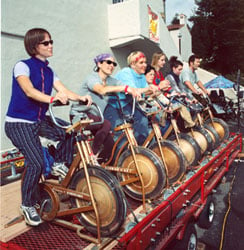Need
History
Design Considerations
Culture
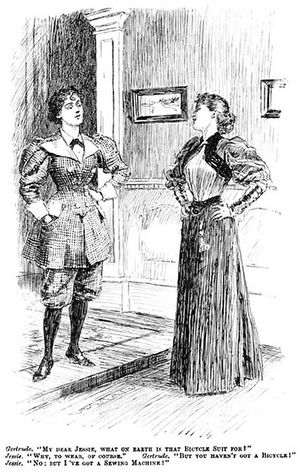
Logistics
Application
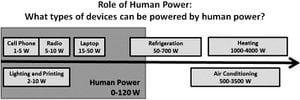
Theory
The natural action of pedaling a bicycle, essentially transforming linear motion into circular motion, creates an oscillatory power function as seen in Figure 2.
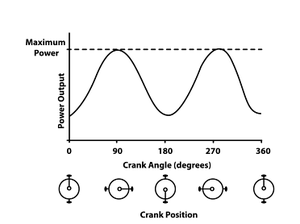
In the case of a mobile bicycle, this effect is masked by three factors: inertia provided by the weight of the rider; frictional losses from equipment; and drag forces from the air. For stationary riders (people operating human-powered machines), however, this phenomenon comes becomes an important consideration in power delivery. For instance, for the milling of grains, it would be favorable to provide a more or less constant power to mill, to facilitate a consistent feed rate through the machine. For this reason, it is often prudent to introduce a means of “smoothing” the power output from the driven gear. The most common way of this is through a flywheel. A flywheel is a rotating mass used in mechanical systems for energy storage. It will substitute for the inertial mass that the rider's weight provides in the mobile example.
For a circular hoop (imagine a bicycle wheel) of radius 'r' and mass 'm', moment of inertia I, is defined by
For a solid disk or cylinder of radius 'r' and mass 'm', the moment of inertia I is given by
Additionally, the kinetic energy of a flywheel is given by where is the angular velocity of the flywheel.
From initial inspection, we can see that for the same mass, the hoop has a higher moment of inertia, by a factor of 2. From an energy perspective, as compared to a solid cylinder, the hoop takes twice as long to reach a steady speed, but takes twice as long to slow down, all things held equal. The primary advantage of a solid-disk flywheel, however, is ease of manufacture.
Construction
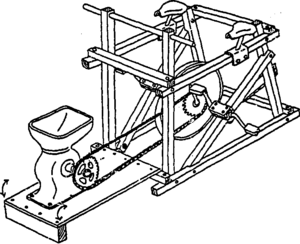
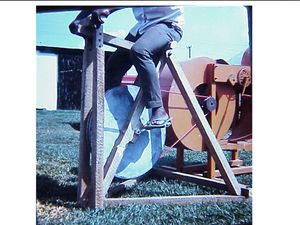
Evaluation
In the realm of electrical power generation, a notable participant in harnessing human energy is NURU Energy.[6]
Impact
Dissemination
While the overall climate for human-powered machinery seems to revolve around bringing power to the developed world, there is domestic interest to resurrect some of this "antiquated" technologies for domestic use. For example, Fender Blender offers a pedal-powered base, inspired by cruiser bicycle aesthetics, for use with a standard blender. Additionally, all of the plastic parts of the machine are made from recycled plastics. [7]
See also
- Animal-powered devices
- Washing and drying clothes
- Bicycle sharing station providing power back to the mains electricity grid[8]
External links
- Pedal Power at CCAT
- Human Powered Appliances discussion at bikeforums.net
- Green MicroGym: contains Human Dynamo, and SportsArt EcoPowr treadmills
- MNM Power, another company making peda power products
- Lucien Gambarota's MotorGym Co Ltd's devices, used by the California Fitness company in Hongkong
- Woodway EcoMill
- Pedal-A-Watt, device for use on bikes
- ↑ Punch1895: London, United Kingdom.
- ↑ Mechtenberg, A.R., et al., Human power (HP) as a viable electricity portfolio option below 20 W/Capita. Energy for Sustainable Development, 2012. 16(2): p. 125-145.
- ↑ Dean, T., The Human-Powered Home2008, Gabriola Island, BC, Canada: New Society Publishers.
- ↑ Weir, A., The Dynapod: A Pedal Power Unit, 1980, Volunteers in Technical Assistance: Mt. Rainier.
- ↑ One man dynapod, Uganda 1972, 1972, Alex Weir.
- ↑ NURU: Energy to Empower. POWERCycle 2012 [cited 2012 11/26/12]; Available from: http://nuruenergy.com/nuru-africa/the-solution/powercycle/.
- ↑ Fender Blender. [cited 2012 12/12/12]; Available from: http://www.rockthebike.com/fender-blender-pro/.
- ↑ Chiyu Chen's Hybrid2 concept
